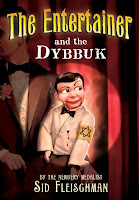

Fleischman, Sid. 2008. The Entertainer and the Dybbuk.
The Entertainer and the Dybbuk by Sid Fleischman won the 2008 Sydney Taylor Book Award in the category of books for older readers. Fleischman won the Newbery in 1987 for The Whipping Boy. Set in the late 1940s, The Entertainer and the Dybbuk is the story of an American ventriloquist, the Great Freddie, who while on his tour of Europe becomes haunted or possessed by the spirit of a Jewish child slain in the Holocaust. This boy, Avrom Amos Poliakov, now a dybbuk or spirit, has unfinished business and he needs this former American soldier's help to be at peace. Now inhabited by this friendly, often sarcastic, mournful soul, his act has become better than ever. The dybbuk is winning the hearts of the crowds. The crowds of course don't realize that this isn't all an act put on by The Great Freddie. He's gone almost overnight from a mediocre-at-best performer to a real crowd-drawing attraction. But being possessed isn't all fun, the dybbuk means business. And he'll stop at nothing to accomplish his goals.
The book is very good, and I definitely recommend it.
First sentence: "In the gray, bombed-out city of Vienna, Austria, an American ventriloquist opened the closet door of his hotel. Still in his tuxedo and overcoat, The Great Freddie intended to put away the battered suitcase in which he carried his silent wooden dummy. But there on the floor sat a gaunt man with arms folded across his knees, waiting."
180 pages
Viewing: Blog Posts Tagged with: A ~ Z Reading Challenge, Most Recent at Top [Help]
Results 1 - 19 of 19
Blog: Becky's Book Reviews (Login to Add to MyJacketFlap)
JacketFlap tags: J Historical Fiction, J Fiction, Jewish Literature Challenge, A ~ Z Reading Challenge, Young Adult Reading Challenge (Shady Glade), Add a tag
Blog: Becky's Book Reviews (Login to Add to MyJacketFlap)
JacketFlap tags: J Historical Fiction, Young Adult Challenge, Young Readers Challenge, A ~ Z Reading Challenge, by the decades challenge, first in a series challenge, Add a tag
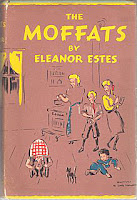
 Estes, Eleanor. 1941. The Moffats.
Estes, Eleanor. 1941. The Moffats.
The Moffats may not be the most exciting, thrilling, page-turning book I've ever read, but it is enjoyable none the less in its quiet, subtle, gentle way. The book focuses on the Moffat family. A mother raising her kids alone. The family is not rich--as you can imagine--but there is a loving, caring atmosphere that makes for a very happy home. The book is episodic. The narrator or main character changes from chapter to chapter. And there is no one connecting plot that threads them altogether. (Well, maybe that isn't quite true. If there is such a plot it would be that their landlord has put their house up for sale. This occurs in the first or second chapter. And the house is sold and the Moffats have to move in the last chapter.) Each chapter is a story of sorts about what life is like--daily life around the house, around school, around town, etc. The stories are mostly lighthearted and fun. But there are some serious moments as well, some moments that border on being a lesson in morality. For readers looking for family-oriented, family-friending reading material, The Moffats is sure to satisfy.
First sentences: The way Mama could peel apples! A few turns of the knife and there the apple was, all skinned! Jane could not take her eyes from her mother's hands. They had a way of doing things, peeling apples, sprinkling salt, counting pennies, that fascinated her.
224 pages
Blog: Becky's Book Reviews (Login to Add to MyJacketFlap)
JacketFlap tags: war, adult fiction, A ~ Z Reading Challenge, Add a tag
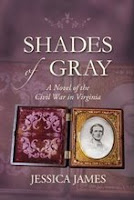
 James, Jessica. 2008. Shades of Gray: A Novel of the Civil War in Virginia.
James, Jessica. 2008. Shades of Gray: A Novel of the Civil War in Virginia.
A piercing blast from a bugle preceded the sound of galloping horses by seconds. Captain Alexander Hunter tore his eyes away from the horse and rider he pursued and focused on a Federal calvary unit now pursuing him.
The title is key here. It lets you know what to expect, and what not to expect. Civil War. Virginia. Any time a novel is set during the Civil War, expect bloodshed. Especially if it's set in Virginia. Shades of Gray. This is of course alluding (is alluding the right word???) to the ethics and morals of war. Not black. Not white. Not even just gray. But shades of gray. So expect lots of ethical dilemmas and 'hard' conversations on what is morally right and wrong and honorable and dishonorable. The first sentence is also important. It lets you know that this isn't a novel about Northern women or Southern women on the home front waiting and praying while their men go off to fight. The narrative places you right in the action.
We have two main characters. One man. One woman. But what you might not be expecting is that both have already been mentioned in that first sentence. One directly, one indirectly. Our hero is a Confederate. A Virginian. Alex Hunter. Our heroine. Well, she goes by many many different names. Andrew Sinclair. Yes, Andrew. Though the Federal army mostly just calls her "Sinclair." Maryann Marlow. Andrea Evans. All but the last being code names. You see, our spunky young heroine (17 when the story opens) is a spy for the Union army. She didn't start out as a spy, not exactly, but her work as a messenger naturally developed into much much more. She is fearless. She is reckless. She is very spirited. She is well matched to oppose Captain Alex Hunter. The two are enemies. Definitely enemies.
The novel is all about torn loyalties, torn allegiances, conflicting interests. The Civil War did tear families apart. It wasn't unheard of for brothers to be on opposite sides facing each other in battle. Immediate and extended families could be torn apart. And lovers. Was it so difficult to imagine that the heart might have its own loyalties? That love might come in unexpected places, in unexpected ways? Alex Hunter does have a brother in the Union army. And this brother is loved. He even goes to his brother's bedside when he is injured. He makes him a promise, a solemn promise to take care of his brother's love, his 'unofficial' betrothed. This woman? None other than Andrea Evans. Though I believe she is going under a different name at the time. She is there too. By his side. He recognizes her not as the boy who has given him chase in the past, but as a woman living in Richmond, Virginia. A woman he's danced with and flirted with. He realizes then that appearances can be deceiving.
Shades of Gray is 524 pages in length. It is complex. The characters are well fleshed out. The plot has many twists and turns. It is an engaging read. Especially the first half of the novel. I didn't want to put it down at all. My eyes kept getting heavier and heavier, but I wanted to keep going. I told myself "just one more chapter" at least half a dozen times. For me, the second half of the novel wasn't quite as good. The plot became a bit messier. The ending, well, I'm not going to have any spoilers but I think the ending should have come 24 pages sooner. If the narrative had ended with the Civil War, I feel it would have been a stronger conclusion. As it is, there are two chapters that serve as an epilogue of sorts. A fifteen years later. And a twenty-five years later (ten years after the fifteen years chapter, but twenty-five years from the Civil War).
Did I like it? Did I enjoy it? Would I recommend it? Yes. Yes. Mostly. I enjoyed this one. I couldn't put it down for the most part. And while the ending left me slightly unsatisfied, the last twenty-four pages do not negate the five hundred pages that I did enjoy. It is still a thoroughly enjoyable read. It was good. I think for those that love Civil War novels it would definitely satisfy. Of course not every one loves historical fiction. And of those that love historical fiction not everyone loves the Civil War setting. And of those that love Civil War settings, not everyone loves those that take place on and off the battlefields. So I think the book definitely should be recommended to those that fall into that area, that target group.
Blog: Becky's Book Reviews (Login to Add to MyJacketFlap)
JacketFlap tags: family, school, J Fiction, A ~ Z Reading Challenge, by the decades challenge, Add a tag
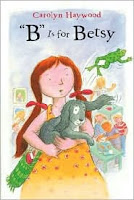
 Haywood, Carolyn. 1939. B is for Betsy.
Haywood, Carolyn. 1939. B is for Betsy.
I'll keep this one short and sweet. I read this book because I've been going way way back this month. (Who knows why???) Anyway, as far as books from the thirties go, this one is charming enough. The heroine is, of course, named Betsy. And the plot is episodic. Each chapter is a new adventure. Most of them center around life at home and life at school. It's not that the book is bad, it's just a bit dated. You can love it, I hope, and still admit that it's dated. (If you grew up with this book and loved it and want to share it with your kids, I don't want to offend you by saying it's "dated." But as an adult reader I've got to be honest and say that I'm not so sure that today's young readers are going to be as charmed with it as their grandmothers may have been. You may pull it off if you do it as a read aloud, but I don't know that a kid would pick this one up on their own and stick with it. Not without some motivation or guidance or exuberance from a trusted adult.)
First sentence: "Betsy lay in her little white bed. She had been awake a long time. Outside her window the birds were calling "Good Morning" to each other, but Betsy did not hear them. All summer long she had jumped out of bed as soon as her eyes were open. She had always run to the window and thrown sunflower seeds out to the birds for their breakfast. But this morning Betsy was so busy feeling unhappy that she forgot all about the birds. Betsy was unhappy because today was the first day of school. She had never been to school and she was sure she would not like it."
159 pages.
Blog: Becky's Book Reviews (Login to Add to MyJacketFlap)
JacketFlap tags: school, J Fiction, J Fantasy, A ~ Z Reading Challenge, dysfunctional families, by the decades challenge, Add a tag
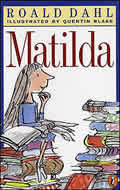
 Dahl, Roald. 1988. Matilda.
Dahl, Roald. 1988. Matilda.
I read this one because I was inspired by Melissa. What can I say about it? It's wild. It's definitely out there. But it's fun. Oodles and oodles of fun. Realistic? Never in a million years. Was it meant to be? Of course not. A zany (how often do I use that word???) over-the-top thoroughly enjoyable read. Matilda is a young genius. (4 or 5 years old) An under appreciated genius at that. Her parents are ghastly. There really isn't any other way to say it. They're abominable. So Matilda has a way of getting back at her parents for their cruel and horrid behavior. Then it's time for Matilda to start school. She's got a good teacher--a teacher that is practically a saint--but the superintendent (my guess is the equivalent of a principal) is evil incarnate. The battle between good and evil has never been quite so strange. Anyway, it's a fun read. But as I said, it probably isn't for everyone.
It's a funny thing about mothers and fathers. Even when their own child is the most disgusting little blister you could ever imagine, they still think that he or she is wonderful. Some parents go further. They become so blinded by adoration they manage to convince themselves their child has qualities of genius. Well, there is nothing very wrong with all this. It's the way of the world. It is only when the parents begin telling us about the brilliance of their own revolting offspring, that we start shouting, "Bring us a basin! We're going to be sick!"
240 pages.
Blog: Becky's Book Reviews (Login to Add to MyJacketFlap)
JacketFlap tags: J Historical Fiction, J Fiction, Jewish, Jewish Literature Challenge, A ~ Z Reading Challenge, by the decades challenge, Add a tag
 Taylor, Sydney. 1951. All Of A Kind Family.
Taylor, Sydney. 1951. All Of A Kind Family.
Originally published in 1951, Sydney Taylor's novel, All of A Kind Family, is set in New York City around 1912. The family consists of a mom, a dad, and five "step and stair" daughters. (They range in age from twelve to four.) The book is about the adventures the five sisters have together. It's definitely not your typical book if you're judging it by modern standards. There is less plot, for one thing, but the charm--or part of the charm--is in the individual stories, the episodes. The fact that it is more a compilation of loosely connected stories masquerading as a novel isn't a problem in my opinion. (But I'm curious what modern children would make of it all???)
The book does have its charms. There's no doubt about that. And one of the things I do like about the book is the fact that it highlights so many different aspects of being Jewish. For example, I haven't come across too many fiction novels (or picture books for that matter) that show families celebrating Purim and Succos. (These aren't the only celebrations by any means.) It was just interesting to see these aspects of culture and religion interwoven with the typical and traditional threads of family life and social life--going to school, going to the library, going to the beach, going shopping, getting a new baby, etc.
Part of me is curious as to how modern readers would respond to this novel and others like it. Would it be considered too old fashioned? Too dated? Too boring? While I can appreciate it the novel as an adult, I'm not sure what I would have thought of it as a child.
For example, the chapter that is really "out there" for me is how the mother tricks the children into doing housework. The chapter is called "Dusting is Fun." And it doesn't matter if you're 8 or 9 or 29, you KNOW that that sentence is a lie and always will be a lie. The mother successfully tricks her five children into playing a game "find the buttons while you dust" to get them to do their least favorite chore each week. I don't buy it. It's not like finding a button is a great reward. It's not like they get to keep the button. It's not like they can trade the buttons for a penny or two to keep. They're just finding the same buttons over and over again each week and making it an-ever-so-fun game. I just don't buy it at all.
However, the rest of the chapters do work for me for the most part.
First sentence: "That slowpoke Sarah!" Henny cried. "She's making us late!" Mama's girls were going to the library, and Henny was impatient.
It is 189 pages.
Blog: Becky's Book Reviews (Login to Add to MyJacketFlap)
JacketFlap tags: J Historical Fiction, J Fiction, Celebrate the Author Challenge, A ~ Z Reading Challenge, by the decades challenge, Add a tag

Wilder, Laura Ingalls. 1939. By the Shores of Silver Lake. Laura was washing the dishes one morning when old Jack, lying in the sunshine on the doorstep, growled to tell her that someone was coming. She looked out, and saw a buggy crossing the gravelly ford of Plum Creek. "Ma," she said, "it's a strange woman coming."
Laura was washing the dishes one morning when old Jack, lying in the sunshine on the doorstep, growled to tell her that someone was coming. She looked out, and saw a buggy crossing the gravelly ford of Plum Creek. "Ma," she said, "it's a strange woman coming."
There is a somewhat large gap between On the Banks of Plum Creek and By the Shores of Silver Lake. We last saw Laura at age 8 or possibly 9. In the beginning of By the Shores of Silver Lake, she is thirteen. And the book's action begins after some melancholy life-altering drama: four of the family had had scarlet fever: Mary, Carrie, Grace, and Ma. (Grace appears with no introduction.) This scarlet fever has left Mary blind.
This "strange woman" is a friend and relation. She is Laura's Aunt Docia. She is there to present Pa with a job offer. Her husband works for the railroad, and she thinks Pa should work for them too. He accepts. But it is decided that he should go alone. Mary isn't ready to travel yet. And the family can go most of the way by train. But it is at this point that we are forced to say goodbye to one of the most beloved fictional dogs of all time, Jack. Jack dies on the eve of Pa going West again.
The novel takes the Ingalls family into South Dakota around DeSmet where the rest of the series is set.
It's not that I don't like this novel. Although I don't. Not really. It's just that in comparison to the other novels (especially On the Banks of Plum Creek and The Long Winter) this one doesn't quite do it for me. I'll be honest. I know Jack was old. I know dogs can't live forever. And I know this is historical fiction based on a true story. Still, my childish self can't quite forgive this book for the death of the dog.
By the Shores of Silver Lake is one of five Newbery Honors that Laura Ingalls Wilder received for her historical fiction "Little House" series. (For those that are curious: 1938 for On the Banks of Plum Creek; 1940 for By the Shores of Silver Lake; 1941 for The Long Winter; 1942 for Little Town on the Prairie; 1944 for These Happy Golden Years).
290 pages.
Blog: Becky's Book Reviews (Login to Add to MyJacketFlap)
JacketFlap tags: J Historical Fiction, J Fiction, Celebrate the Author Challenge, series challenge, A ~ Z Reading Challenge, by the decades challenge, 888 Challenge, Heart of a Child Challenge, Add a tag
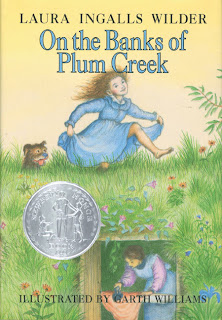
Wilder, Laura Ingalls. 1937. On the Banks of Plum Creek.
The dim wagon track went no farther on the prairie, and Pa stopped the horses. When the wagon wheels stopped turning, Jack dropped down in the shade between them. His belly sank on the grass and his front legs stretched out. His nose fitted in the furry hollow. All of him rested, except his ears.
On The Bank of Plum Creek opens when the Ingalls family arrives at their new home. They have bought a place, and their first new "home" is a dugout. They are buying it from a Norwegian man, Mr. Hanson, who is moving further west I presume. This is just temporary. Charles (or "Pa" as he's referred to so often it's hard not to join in) has promised to build them a real house, a real home just as soon as he can. The book opens with promises and hopes and dreams. But most of the book will see those hopes and dreams delayed. What Pa needs--what they all need--are good crops, good wheat crops. What Pa gets is grasshoppers. The Ingalls family does struggle a bit in On The Banks of Plum Creek. But they do settle in and get comfortable. Mary and Laura, for instance, start school. It is the first time for them to ever attend school. And they do meet up with some town folks like Nellie Oleson.
Overall, this is a more than enjoyable read. Some of my favorite chapters are "Nellie Oleson," "Town Party," "Country Party," "Going to Church," and "Surprise."
It is 339 pages.
Blog: Becky's Book Reviews (Login to Add to MyJacketFlap)
JacketFlap tags: J Historical Fiction, J Fiction, A ~ Z Reading Challenge, by the decades challenge, Young Adult Reading Challenge (Shady Glade), Add a tag
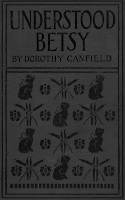
Fisher, Dorothy Canfield. 1917. Understood Betsy.
When this story begins, Elizabeth Ann, who is the heroine of it, was a little girl of nine, who lived with her Great-aunt Harriet in a medium-sized city in a medium-sized state in the middle of this country; and that's all you need to know about the place, for it's not the important thing in the story; and anyhow you know all about it because it was probably very much like the place you live in yourself.
Elizabeth Ann is an orphan raised by her great-aunt Harriet and her aunt Frances. The first chapter shows the reader just how life as she knew it was for Elizabeth Ann. To say she was coddled would be a bit of an understatement. To say that both aunts and niece were a bit psychologically unsound would be a bit closer to the truth. It's not that they're crazy crazy. It's just that they're anxious, jittery, nervous, worrisome, panicky, fidgety, chicken-little-y type people. They're sweet and docile enough, but they lack gumption and ingenuity and vitality.
Understood Betsy is the story of how Elizabeth Ann transforms into Betsy. It all starts when one of her caretakers gets diagnosed with an unnamed disease. (If they named it, I sure missed it. But I think the main point was to get the two aunts out of the picture.) Elizabeth Ann is sent to live with the other side of the family. Her aunt (Abigail) and uncle (Henry) and first cousin (Ann). They live in Vermont, I believe.
From the very beginning, Elizabeth Ann knew that she was entering the unknown. On her way to her new home--in the buggy--she has her first enlightened moment. "It is possible that what stirred inside her head at that moment was her brain, waking up. She was nine years old, and she was in the third-A grade at school, but that was the very first time she had ever had a whole thought of her very own." (21)
Her awakening, her transformation is entertaining enough and the descriptions of life and family are charming as well. I think some readers will love Betsy, understand Betsy; but I'd be silly if I didn't acknowledge the fact that some readers would find Understood Betsy to be boring or quaint. Anyway, long story short...I loved it. I thought it was great. If I had discovered this as a child--like my mother did and most likely my grandmother did--I'm sure I would have loved it. I'm sure I would have read it over and over again.
You can find the entire book--including illustrations--online.
Blog: Becky's Book Reviews (Login to Add to MyJacketFlap)
JacketFlap tags: adventure, J Fiction, J Fantasy, Quest, Speculative Fiction Challenge, series challenge, A ~ Z Reading Challenge, Add a tag

Mull, Brandon. 2007. Fablehaven: The Rise of the Evening Star.
It has now been a year since Kendra and Seth have visited their grandfather and grandmother (whom we first met as a chicken) on their Fablehaven estate (or preserve to be a bit more accurate). Our narrative opens with Kendra anticipating the last week of school--her last week at a middle school. It's an unusual time for a school--a class--to receive a new student--with only one week to go--but only Kendra knows quite how strange it is. The new student? Not human. A monster. A monster with foul breath. When Kendra's unable to reach her grandfather, she decides to trust the man who claims to be sent at her grandfather's request. A man called Errol. Kendra and Seth thus end their school year with a bit of adventure and danger and mystery. Soon summer will be here. The summer may just hold another action-packed, adventure-filled, mystery-solving, danger-ridden, journey for the two as they visit their grandparents once more. Full of action, suspense, mystery, and adventure...this second book is even better than the first.
Blog: Becky's Book Reviews (Login to Add to MyJacketFlap)
JacketFlap tags: J Historical Fiction, J Fiction, Young Readers Challenge, A ~ Z Reading Challenge, by the decades challenge, Add a tag
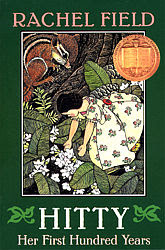
Field, Rachel. 1929. Hitty: Her First Hundred Years.
The antique shop is very still now. Theobold and I have it all to ourselves, for the cuckoo clock was sold day before yesterday and Theobold has been so industrious of late there are no more mice to venture out from behind the woodwork. Theobold is the shop cat--the only thing in it is that is not for sale, which has made him rather overbearing at times. Not that I wish to be critical of him. We all have our little infirmaties and if it had not been for his I might not now be writing my memoirs. Still, infirmities are one thing, and claws are another, as I have reason to know.
Hitty, Her First Hundred Years won the Newbery award in 1930. Who is Hitty? Hitty is a doll. A wooden doll made from the ever-lucky mountain-ash wood. Her story begins when an Old Peddler--old peddlers are so rarely named in books--takes refuge with a family in Maine. Mrs. Preble is awaiting the return of her husband--who is a whaler--and she has the children to care for. One of her children is a young girl named Phoebe. (The other is a boy named Andy.) The Peddler takes refuge in the storm, but ends up staying quite a while with the family. At some point during his visit, he carves this doll--soon named Mehitabel--for the little girl. Phoebe's told she must sew clothes for the doll before she can be played with--and one of the items Phoebe makes is an undergarment--a chemise--with "Hitty" cross-stitched on it.
Hitty's adventures span the globe and span generations. Sometimes her change of locale is purposeful--when the Preble family takes her on a ship's voyage to the South Seas--and other times it is quite accidental--when Phoebe drops the doll in India and she is "discovered" by a wandering snake charmer. She has many different owners; she has many different adventures. Throughout it all, she tries to hold on to as much grace and dignity as she can. Which isn't always easy. (Like when she's made an idol in the South Seas.)
The book is illustrated by Dorothy P. Lathrop. The illustrations are black and white. And they are very likely the original illustrations for the book. Original art is important I know to preserving the feel of a book at times. (Like I would be monstrously upset if someone removed Garth Williams illustrations from the Little House books. Oh wait, somebody did. And it was wrong, wrong, wrong.) But when I see beautiful new editions of The Wind in the Willows or Alice in Wonderland or The Secret Garden. Editions with incredible illustrations. I can't help but wishing that Hitty will one day get the same treatment. My choice? Bagram Ibatoulline.
When I was reading The Miraculous Journey of Edward Tulane, I thought. I bet this book must be like Hitty. I'd never read Hitty. It was just a hunch. An educated guess. A guess that turned out to be all too accurate. Hitty didn't start out unloved, mind you, and she was never nailed to a stake and used as a scarecrow. However, she did spend decades folded up in a horsehair sofa in an attic. The similarities are interesting.
Hitty, Her First Hundred Years was a good read for me. I enjoyed it. I thought it was charming in some places. Interesting in others. There were just a few sentences here and there that might be jarring to the modern reader. For example, early on in her life--turn of the nineteenth century--Hitty refers to Native Americans as 'Injuns'. Phoebe and Andy are out picking blackberries or blueberries or some sort of berry. They wander too far away and see Indians in the distance. Both get so frightened that they run away. In the chaos--the Indians never saw them or chased them--Phoebe drops her doll and later worries that the 'Injuns' might have taken her. And a few chapters later, when the Preble family is sailing--in a whaling ship--the South Seas. A storm leaves them stranded on an island with "savages."
Blog: Becky's Book Reviews (Login to Add to MyJacketFlap)
JacketFlap tags: Historical Fiction, Fantasy, Cardathon Challenge, A ~ Z Reading Challenge, Add a tag
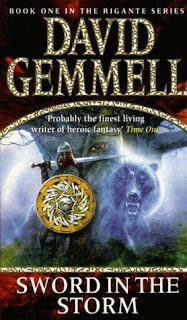
Sword in the Storm by David Gemmell is book one in the Rigante series. It's also one of the reasons I started the Cardathon. Let me explain. Yes, I started the Cardathon to introduce others to the glory-that-is Orson Scott Card. But it was also selfish. I wanted the chance to read some books that were Card-recommended. I would read Card's essays/articles about the books he was reading and be intrigued, curious. Card's thoughts on Gemmell intrigued me. Here is an author--Gemmell--that I've never heard of. And Card is praising him enthusiastically. You can read his review of David Gemmell's Rigante series here. I knew immediately that I would want to read some to experience it for myself--to see if it was really as good as Card claimed.
Sword in the Storm is 439 pages of pure pleasure. It's historical fantasy. But--and this is purely my take on it--it is fantasy that is done in such a way that it doesn't feel like fantasy. It feels real. The world is so well-crafted, so well-grounded. The characters so human, so life-like. It just feels real. Yes, there are some magical powers going on. (The Seidh) (Especially crucial is the Morrigan. Though I think the spelling may be altered in the novel.) But they feel real. They don't feel like make believe. It was a world, a time and place, that I thoroughly bought into.
The first book--the only book I've read so far--follows the life of a tribe--the Rigantes--based on the Celts of Britain. They never say the word "Britain." And the closest you get to "celt" is "Keltoi" but when you read it there is little doubt where it is set. Similarly, the threat--the people, the soldiers, of "Stone" are never called "Romans." But the reader knows who the soon-to-be enemies/conquerors are.
Never has a book been so rich, so fully immersed in culture WHILE at the same time being so full of action and intensity. The characters are well-developed. It doesn't matter if they're major or minor. All the characters have a life, a spark of their own. Each plays a role in the drama. Each is important. The whole community--the whole tribe--is given life. His characters are so human, so believable. They're full of flaws, but they're still--for the most part--so likable. You understand them. If they do good. If they do bad. You feel you know why. You understand why. The action? Intense. Whether plotting a romance or preparing for great battle scenes, the pacing is unbelievable. All of it is so good. It really keeps the pages turning.
I think I will take a hint from Card and not talk too much about the characters themselves. This is one you need to read for yourself.
I have actually said nothing about the characters themselves. For good reason: I don't want to mar them by trying to summarize who they are.
For Gemmell has done something that is rarely attempted outside the fantasy genre and rarely done well within it. He has created characters of nobility and honor, and has done it so well that instead of seeming larger than life, they never lose their humanity.
Anyway, I can't recommend this one highly enough!!!! Read this book!
Blog: Becky's Book Reviews (Login to Add to MyJacketFlap)
JacketFlap tags: classic, Jane Austen mini-challenge, Nineteenth Century Women Writers' Challenge, A ~ Z Reading Challenge, by the decades challenge, 888 Challenge, Add a tag

How do I love thee? Let me count the ways....
Persuasion by Jane Austen has to be--without a doubt--my favorite, favorite Austen novel. I've only read it twice, but each time was oh-so-magical. Though I will *admit* that it perhaps isn't a book that will "grab" you from page one. It might take some patience and effort, but give it a chapter or two (or three) and you might just find yourself swept up in the story of Anne Elliot.
Sir Walter Eliott, of Kellynch-hall, in Somersetshire, was a man who, for his own amusement, never took up any book but the Barnetage; there he found occupation for an idle hour, and consolation in a distressed one; there his faculties were roused into admiration and respect, by contemplating the limited remnant of the earliest patents; there any unwelcome sensations, arising from domestic affairs, changed naturally into pity and contempt, as he turned over the almost endless creations of the last century--and there, if every other leaf were powerless, he could read his own history with an interest which never failed--this was the page at which the favorite volume always opened: Elliot of Kellynch-Hall.
See what I mean about NOT being an opening that will hook you? Long story short...or three reasons why you should read Persuasion despite its verbose, pompous opening....
1) It is the story of Anne Elliot. A middle child, a daughter obviously, born into a pompous and atrocious family muddles through the best she can while waiting for her Prince to come. (Okay, she's not really waiting for her Prince to come and rescue her. She's all but given up on love since she's also, at age 27, an "old maid.")
2) Despite coming from a ghastly, horribly obnoxious family, Anne herself is not only intelligent and genuine but she's also thoroughly enjoyable and likable. She has a wit and cleverness about her. She actually sees the world around her. She isn't blind to reality like so many of the other characters.
3) Persuasion is all about second chances. Anne Elliot, a girl who truly deserves good things because her family is so rotten, lost her one chance for love and happiness eight years before our narrative opens. Her heart belonged--then and now--to a young man, a sailor, Frederick Wentworth. But her family and friends deemed him unworthy and unacceptable. And forced into choosing between her family and her love, she chose her family. A decision she regretted from the moment she broke her lover's heart.
When Persuasion opens the reader learns that hard times have come to the Elliot family--a family mostly known for its arrogance and pride. The family is *forced* into renting their out their estate to an Admiral Croft and his wife. The Elliot family--all but Anne--will reside in Bath year round. Anne, poor Anne, only Anne, will be parceled out as need be between Bath and her father and older sister, Elizabeth, and her younger sister, Mary.
What can I say about Mary? Mary is interesting--and by interesting I mean obnoxious and annoying--in a completely different way than her father, Sir Walter, and her sister, Elizabeth. Mary is married to Charles. Charles Musgrove. Charles and Mary and their two children live on the estate--in a smaller house--as his parents and his sisters. They live in the "great house." Anne's time spent with her sister and her sister's in-laws is interesting to say the least. Mainly because someone has just arrived in the neighborhood. A Captain Wentworth. Captain Frederick Wentworth.
Just the sight of him makes her heart skip a beat--or two or three--she loves him like she's always loved him. But he's out of reach. He's now courting--of all people--one of the Musgrove sisters.
Love. Requited. Unrequited. Broken hearts. Regret. Jealousy. Disappointment. Frustration. It's all there with just a little more besides.
I do not want to spoil this one for anyone. Really. I don't want to. So please, please, please stop reading if you haven't read the novel. I mean it.
S
P
O
I
L
E
R
There are just a few scenes--one really big scene--that makes this novel oh-so-magical. That takes it from nice to really really great.
I love, love, love the conversation between Anne Elliot and Captain Harville. Their discussion on which sex--which gender--loves most, loves deepest, loves truer is one of the best dialogues ever. Seriously. Mostly because of the heart-felt letter that is the result of Captain Wentworth overhearing that conversation. That letter? The best, most romantic love letter of ALL TIME. Who could not love this guy?
I can listen no longer in silence. I must speak to you by such means as are within my reach. You pierce my soul. I am half agony, half hope. Tell me not that I am too late, that such precious feelings are gone forever. I offer myself to you again with a heart even more your own than when you almost broke it eight years and a half ago. Dare not say that a man forgets sooner than woman, that his love has an earlier death. I have loved none but you. Unjust I may have been, week and resentful I have been, but never inconstant. You alone have brought me to Bath. For you alone I think and plan.
The letter goes on, but I think you get the idea. Anyway, as much as I love Pride & Prejudice (and I do) I've just got to give the award to Anne and Captain Wentworth when it comes to love and romance. Okay, it only wins by a small margin--because Darcy is quite a letter-writer as well. And he is oh-so-dreamy in his own ways. But Anne, Anne is what makes this book so wonderful. She's a heroine that has nothing to recommend her but her self--her true self. A self that only a few recognize as a thing of beauty, a thing of great worth.
Let's compare Wentworths...first the 1995 Persuasion, then the 2008 Persuasion.

Now let's compare Anne Elliots...first the 1995 Persuasion, then the 2008 Persuasion

There is a cool character chart for the new movie.
As for the movies, I think I will *always* prefer the 1995 version. Even though none of the characters are glamorously beautiful, they're real and genuine. And that movie is *closer* to the book than this latest version. The real crime--in my opinion--is that they DID NOT HAVE the ultra-romantic scene with Captain Harville and Anne Elliot. They abbreviate that conversation down to a few lines, put it very nearly in the beginning, and have it taking place between Anne and a Captain Benwick. Therefore Wentworth can't overhear it, and doesn't have the *proper* motivation to write that beautiful, beautiful letter. Instead they invent a new excuse or else completely gloss over motivation entirely and have the letter showing up without provocation or reason. It's just suddenly there in the script. Silly, silly writers. Why mess with the majesty of the perfect scene???? If the new movie HAD bothered to get it right, perhaps there would be some competition between the two.
Blog: Becky's Book Reviews (Login to Add to MyJacketFlap)
JacketFlap tags: science fiction, Cardathon Challenge, Speculative Fiction Challenge, series challenge, sci-fi experience 2008, A ~ Z Reading Challenge, Short Story Reading Challenge, by the decades challenge, Add a tag
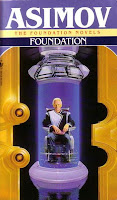
Some books feel like friends from the very beginning. Such is the case with Isaac Asimov's novel, Foundation. This book was originally the first in a series of Foundation novels. (However, Prelude to Foundation has since been published.) The novel is composed of five sections. Four of these sections were originally published separately and appeared as short stories in Astounding Magazine between 1942 and 1944. They were later compiled together into one volume in 1951 alongside a newly written introduction section, and thus Foundation as we know now it was published. (Does any of that matter? Not really. I didn't read the details on the publishing history until after I read it. But as an after note, I was intrigued by it. So I thought I'd share it with you.)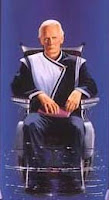 For twelve thousand years the Galactic Empire had ruled supreme. Now it was dying. But only Hari Seldon, creator of the revolutionary science of psychohistory, could see into the future--a dark age of ignorance, barbarism, and warfare that would last thirty thousand years. To preserve knowledge and save mankind, Seldon gathered the best minds in the Empire--both scientists and scholars--and brought them to a bleak planet at the edge of the Galaxy to serve as a beacon of hope for future generations. He called his sanctuary the Foundation.
For twelve thousand years the Galactic Empire had ruled supreme. Now it was dying. But only Hari Seldon, creator of the revolutionary science of psychohistory, could see into the future--a dark age of ignorance, barbarism, and warfare that would last thirty thousand years. To preserve knowledge and save mankind, Seldon gathered the best minds in the Empire--both scientists and scholars--and brought them to a bleak planet at the edge of the Galaxy to serve as a beacon of hope for future generations. He called his sanctuary the Foundation.
But soon the fledgling Foundation found itself at the mercy of corrupt warlords rising in the wake of the receding Empire. Mankind's last best hope was faced with an agonizing choice: Submit to the barbarians and be overrun--or fight them and be destroyed.
What can I say about Foundation without giving too much away? It is one of those rare books where it's best not to know. Best not to have preconceived notions of what it's all about. Best not to think too much about what it's saying and where it's going. It's best to just go along for the ride on this one.
The settings? Various planets. The characters? Too many to list. The plot? Complex but not difficult to follow. Each section of the book is separate from the whole. Most are divided by time. Between sections, thirty years, eighty years, fifty years, a hundred years could have passed. The reader picks up hints here and there about how much time has gone by. But this isn't a book where you follow characters around. This is more of a novel where ideas play the leading role.
If there is a cohesive theme to the novel it is manipulation. Whether passive or aggressive, Foundation is all about power struggles, manipulations, and getting others to do what you want when you want. It is all about ambition.
Do not look at this chart unless you want to confuse yourself. (Or you've read a good many of the books already.) For plot summary of the first novel, click here. For more information on the series as a whole, click here.
Blog: Becky's Book Reviews (Login to Add to MyJacketFlap)
JacketFlap tags: friendship, war, YA Historical Fiction, Jewish, international literature, Travel the World, Jewish Literature Challenge, Young Adult Challenge, Printz Award Challenge, A ~ Z Reading Challenge, Add a tag
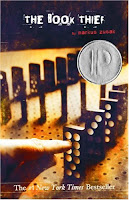
Zusak, Markus. 2006. The Book Thief.
The Book Thief may just be the hardest book I've ever tried to review. It is beautiful. Though it can be ugly. It is intense. It is powerful. It is memorable. The first thing you should know about The Book Thief? It is narrated by Death. This is fitting in many ways since the setting is Nazi Germany during the Second World War. Death is the narrator, and he never lets you forget it. But there are many players--many characters--in the story that Death is relating to his audience all these years later. One of them is a girl, Liesel, and is known by Death as 'the book thief.' These thefts provide some structure to the text. (The structure is one of the odd things about the Book Thief. It isn't chronological. Death doesn't tell a story traditionally. He has his own way of jazzing it up, arranging it so it suits his needs and purposes.) The language, the style, is unique. I think it is written in such a way that you either really love it or you really don't. (It's written in such a way that you could almost open it to any page, and find a sentence or two or a whole paragraph that you want to just lift out and let resonate with you for a time.) This is how it begins:
This is how it begins:
First the colors. Then the humans. That's usually how I see things. Or at least, how I try. Here is a small fact: you are going to die. I am in all truthfulness attempting to be cheerful about this whole topic, though most people find themselves hindered in believing me, no matter my protestations. Please, trust me. I most definitely can be cheerful. I can be amiable. Agreeable. Affable. And that's only the A's. Just don't ask me to be nice. Nice has nothing to do with me. (3)
It continues:
People observe the colors of a day only at its beginnings and ends, but to me, it's quite clear that a day merges through a multitude of shades and intonations, with each passing moment. A single hour can consist of thousands of different colors. Waxy yellows, cloud-spat blues. Murky darknesses. In my line of work, I make it a point to notice them. As I've been alluding to, my one saving grace is distraction. It keeps me sane. It helps me cope, considering the length of time I've been performing this job. The trouble is, who could ever replace me? Who could step in while I take a break in your stock-standard resort-style vacation destination, whether it be tropical or of the ski trip variety? The answer, of course, is nobody, which has prompted me to make a conscious, deliberate decision--to make distraction my vacation. 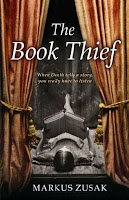 Needless to say, I vacation in increments. In colors. Still it's possible that you might be asking, why does he even need a vacation? What does he need a distraction from? Which brings me to my next point. It's the leftover humans. The survivors. They're the ones I can't stand to look at, although on many occasions I still fail. I deliberately seek out the colors to keep my mind off them, but now and then, I witness the ones who are left behind, crumbling among the jigsaw puzzle of realization, despair, and surprise. They have punctured hearts. They have beaten lungs. Which in turn brings me to the subject I am telling you about tonight, or today, or whatever the hour and color. It's the story of one of those perpetual survivors--an expert at being left behind. It's just a small story really, about, among other things: a girl, some words, an accordionist, some fanatical Germans, a Jewish fish fighter, and quite a lot of thievery. (4-5)
Needless to say, I vacation in increments. In colors. Still it's possible that you might be asking, why does he even need a vacation? What does he need a distraction from? Which brings me to my next point. It's the leftover humans. The survivors. They're the ones I can't stand to look at, although on many occasions I still fail. I deliberately seek out the colors to keep my mind off them, but now and then, I witness the ones who are left behind, crumbling among the jigsaw puzzle of realization, despair, and surprise. They have punctured hearts. They have beaten lungs. Which in turn brings me to the subject I am telling you about tonight, or today, or whatever the hour and color. It's the story of one of those perpetual survivors--an expert at being left behind. It's just a small story really, about, among other things: a girl, some words, an accordionist, some fanatical Germans, a Jewish fish fighter, and quite a lot of thievery. (4-5)
Before the story gets underway, he invites the reader along for the journey:
Yes, often, I am reminded of her, and in one of my vast array of pockets, I have kept her story to retell. It is one of the small legion I carry, each one extraordinary in its own right. Each one an attempt, an immense leap of an attempt--to prove to me that you, and your human existence, are worth it. Here it is. One of a handful. The Book Thief. If you feel like it, come with me. I will tell you a story. I'll show you something. (14-15)
There is depth, substance, to these words, to this story. The descriptions. The details. The powerful sway of the words whether they're describing the beauty of love and family and friendship or capturing the ugly heaviness of hate, anger, and death. It's not an easy story to read. It's full of emotions. It's full of words. It's a book that at it's very heart and soul captures humanity in all its depths--the good, the bad, the ugly. Here is a book that captures what it means to be human.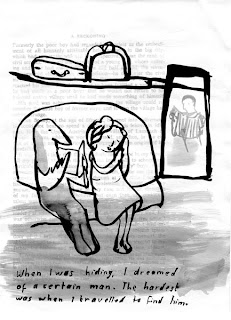 One of the most memorable passages for me (224-236), and I hope this isn't much of a spoiler--is the hand drawn--hand written--portion written by "Max" for Liesel. I find it so powerful in its simplicity. So hauntingly beautiful. There is a second story specially written for Liesel by Max, this second one is found on pps 445-450. This is how that one begins, "There was once a strange, small man. He decided three important details about his life: 1) He would part his hair from the opposite side to everyone else. 2) He would make himself a small, strange mustache. 3) He would one day rule the world." (445)
One of the most memorable passages for me (224-236), and I hope this isn't much of a spoiler--is the hand drawn--hand written--portion written by "Max" for Liesel. I find it so powerful in its simplicity. So hauntingly beautiful. There is a second story specially written for Liesel by Max, this second one is found on pps 445-450. This is how that one begins, "There was once a strange, small man. He decided three important details about his life: 1) He would part his hair from the opposite side to everyone else. 2) He would make himself a small, strange mustache. 3) He would one day rule the world." (445)
Blog: Becky's Book Reviews (Login to Add to MyJacketFlap)
JacketFlap tags: classic, A ~ Z Reading Challenge, Short Story Reading Challenge, by the decades challenge, Add a tag
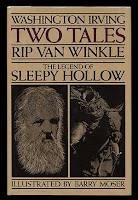
Irving, Washington. Two Tales: Rip Van Wrinkle and The Legend of Sleepy Hollow. Illustrated by Barry Moser.
Perhaps I should be slightly embarrassed to admit this, but this was my first time actually reading both of these stories. My only familiarity with the stories coming through Wishbone in the first instance and a cartoon in the second. (I want to say Disney but I could be wrong.) So why now? Well, I is a difficult letter in the alphabet, AND I was desperate to read a book from the 1820s to complete my loop. Those two aren't great reasons to read a classic, but in all honesty, they were sufficient to motivate me at the library. My impression of the book? Well, I enjoyed them both more than I thought I would. But that isn't necessarily saying much. The language is a bit archaic. Not desperately archaic. But without being *updated* I don't see many kids being able to read it smoothly. Even as a somewhat well-read, somewhat well-educated adult, there were words that in all honesty I had NO idea what they meant. And I would assume that like most readers, I was just too lazy to get up and get a dictionary so I just skimmed over them like they weren't even there. (To my credit, 11 at night isn't the best time to get up and go in search of a dictionary.) But I got the *main* ideas of both stories.
My impression of the book? Well, I enjoyed them both more than I thought I would. But that isn't necessarily saying much. The language is a bit archaic. Not desperately archaic. But without being *updated* I don't see many kids being able to read it smoothly. Even as a somewhat well-read, somewhat well-educated adult, there were words that in all honesty I had NO idea what they meant. And I would assume that like most readers, I was just too lazy to get up and get a dictionary so I just skimmed over them like they weren't even there. (To my credit, 11 at night isn't the best time to get up and go in search of a dictionary.) But I got the *main* ideas of both stories.
The first being a tale of a lazy man with a nagging wife falls into a magical sleep that does him not much practical good but at least rids him of his wife. I can't help but feel for the wife. ANY woman would get annoyed with a man who was THAT lazy and irresponsible. And doubly annoyed that he could at times be helpful to other families, other women, but ignored his own. So this tale doesn't really have a *moral* per se that would prove beneficial. Rip Van Wrinkle was lazy; he was happy to be lazy; he taught his son to be lazy; he liked being waited on hand and foot and the magical sleep just made that happen without the nagging.
The second being a tale of a rather comical school teacher, Ichabod Crane. Ichabod was a school teacher, a singing teacher, and a rather unsuccessful wooer. He wanted to win the heart of a lovely lady. But his competition was, well, the competition got the best of him in the end. Brom Bones. Practical joker extraordinaire. It was an entertaining story about a man who let himself be *scared* out of what he wanted. Can I blame him? Not really. Being chased by a "headless" man and then having aforementioned head tossed at him....would scare me out of town as well.
Overall, both stories were okay. But the artwork of Barry Moser just didn't do much for me. It seemed to date the book. It was originally published in 1984, and the book just looks and feels and smells dated. But in its defense, it was on the shelves while the newer versions of both tales (with better illustrations perhaps) were not. So it served its purpose.
Blog: Becky's Book Reviews (Login to Add to MyJacketFlap)
JacketFlap tags: adult fiction, humor, classic, Cardathon Challenge, A ~ Z Reading Challenge, by the decades challenge, Add a tag

The Diaries of Adam & Eve Translated by Mark Twain. Illustrated by Michael Mojher.
This compilation combines several writings by Mark Twain. It weaves together the texts of both Adam and Eve's diaries. You can see snippets of both here and here. (Adam first, then Eve.)
One of the reviews I read notes that, "The Diaries of Adam and Eve contains a good sample of Twain's wry humor and his observations on the human condition. He portrays Adam as a man who would as soon sit around and do nothing, but whose curiosity eventually gets the better of him once it is sparked by Eve. Eve is seen as a curious woman who wants to understand everything around her and has the need to share it with any person who will listen, limited, at first, to Adam, who is passably indifferent to Eve and her passions." Another calls it a "spoof" of the creation story in Genesis. While it's true that it is slightly irreverent, I see it as capturing the bewilderment and awe of life as it might have been. It's not like there was an instruction manual. And their confusion, curiosity, and naive wonder at things we take for granted make for an enjoyable, funny, lighthearted read. At its simplest it is a funny look at how humans learned to be human. One of the more humorous sections is on how they became parents. Eve seems to "get" the baby thing more than Adam ever does. Anyway, I don't want to give too much away. But it is a short, simple, sweet book that I'd consider a must-read at some point in your life. I agree with the Amazon reviewer who wrote, "If there is a shorter, funnier, more delightful book on the planet, I have yet to find it. The genius that was Twain's is in abundant evidence here."
Blog: Becky's Book Reviews (Login to Add to MyJacketFlap)
JacketFlap tags: TBR Reading Challenge, YA Fantasy, YA Romance, Young Adult Challenge, Speculative Fiction Challenge, Winter Reading Challenge, A ~ Z Reading Challenge, 2007, series challenge, Chunkster Challenge, Add a tag
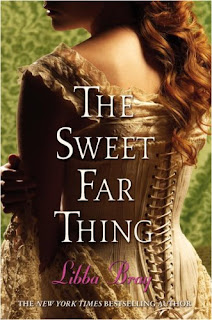
Bray, Libba. 2007. The Sweet Far Thing.
The Sweet Far Thing concludes the trilogy following Gemma Doyle and her quests in and out of the realms. (The first being A Great and Terrible Beauty which I read at least six months or so before I started blogging so there's no record of what I thought. And the second being Rebel Angels which I reviewed last winter/spring.) The book is heavy both in content and weight. 819 pages. Most of them of seventeen-year-old Gemma confused about who she is and what she wants. At the end of Rebel Angels, Gemma bound the magic of the realms to herself. She had promised several different peoples or tribes that she would later share the magic and make peace throughout the realms; she would issue in a new era of peace and unity. The close of Rebel Angels also saw the death of Circe. (or did it???)
The Sweet Far Thing picks up three months later. It is spring. Felicity and Gemma are getting ready to make their debut in society. And Ann, poor Ann, is still going to be a governess. She's still being treated horribly by the other girls at Spence Academy. Mrs. Nightwing is planning a big masked ball in honor of the graduating class--the class of which Gemma and Felicity and Ann are a part. The other buzz around campus is the ongoing work to complete the East Wing. Mrs. Nightwing is determined that the East Wing which was originally destroyed by fire twenty-five years before, needs to be rebuilt in order for Spence to regain its honor and prestige. But there are many people who fear what will happen when the East Wing is rebuilt. They're afraid of what might become unsealed and unburied. The Gypsies. Mother Elena especially is full of warnings. Most of which go unheeded. But such is the way with those that prophesy foreshadowing.
Getting back to Gemma. Gemma was having an identity crisis of sorts in Rebel Angels. She feared that no one really loved her for her. That her father and grandmother and brother all have their own "idea" of who she is. An idea that is far from reality. And she's worried that her friends just love her, just include her because of her magic, because of her power. She was tempted for a while by a boy, Simon, but then felt he didn't love her for her, know her for her either.
This quote is from Rebel Angels:
To Felicity and Ann, I’m a means into the realms.
To Grandmama, I am something to be molded into shape.
To Tom, I am a sister to be endured.
To Father, I am a good girl, always one step away from disappointing him.
To Simon, I’m a mystery.
To Kartik, I am a task he must master.
My refelection stares back at me, waiting for an introduction. Hello, girl in the mirror. You are Gemma Doyle. And I’ve no idea who you really are. (396-397)
Back to Sweet Far Thing. So Gemma is still learning who she is, what she wants, what she needs, and even learning what she fears most. When the book opens, the reader learns that Gemma has not been able to regain access to the realms. She can no longer conjure up the white door. She has seemingly lost her power. Also of note, the dreams and visions have stopped for the most part. But with 819 pages, the reader knows this powerlessness won't last long. Gemma will find a way; she always finds a way to get what she wants or what she thinks she wants.
There is mystery, confusion, epic battles between good and evil, trickery, betrayal, secrets, lies, love and lost love, fear and hope. There is family drama and school drama. And drama between friends as boundaries are pushed or nudged and little lies are told. Fans of the series will no doubt be anxious to read this saga through to its bittersweet conclusion. (I read it in two days.) But I'm unable to predict how they'll feel about the ending. I know my response. (Though I won't go there here in this post.) But how will fans react?
Blog: Becky's Book Reviews (Login to Add to MyJacketFlap)
JacketFlap tags: A ~ Z Reading Challenge, Reading Challenges, Add a tag
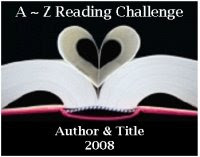
Joy of Thoughts of Joy is hosting the A to Z Challenge. It is to read A to Z authors AND A to Z titles. She writes, "All that's required is that you align the author's last name or the title of a book (excluding "the", "a", etc.) with its corresponding letter in the alphabet. Each author and title entry must be a different book. I will be working on both the author and title lists at the same time; however, you may complete the alphabet lists anyway that suits your fancy. The challenge last throughout the 2008 year."
Your books can overlap with other challenges. So that is GREAT incentive for me. I'm not sure which titles I'll read yet. But I'm sure I'll have fun as I go.
AUTHOR LIST
"A" ~
"B" ~
"C" ~
"D" ~
"E" ~
"F" ~
"G" ~
"H" ~
"I" ~
"J" ~
"K" ~
"L" ~
"M" ~
"N" ~
"O" ~
"P" ~
"Q" ~
"R" ~
"S" ~
"T" ~
"U" ~
"V" ~
"W" ~
"X" ~
"Y" ~
"Z" ~
TITLE LIST
"A" ~
"B" ~
"C" ~
"D" ~
"E" ~
"F" ~
"G" ~
"H" ~
"I" ~
"J" ~
"K" ~
"L" ~
"M" ~
"N" ~
"O" ~
"P" ~
"Q" ~
"R" ~
"S" ~
"T" ~
"U" ~
"V" ~
"W" ~
"X" ~
"Y" ~
"Z" ~



Yours is the second favorable blog review I've read on this book. I think I'm going to have to give it a try.
Oh this really does sound good Becky! I'm going to have to go by the LIBRARY (!) and see if they have it :)
This one sounds interesting, and I've never heard of it.
Thanks!
I've only read a few of Twain's books, but I loved them all. I don't think I'd ever even heard of this one before, and it sounds awesome. Thanks for the great review!